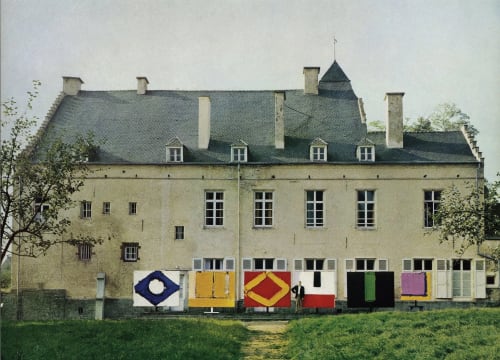Vigo is proud to present a selection of Bram Bogart’s Ohain paintings, amongst his most outstanding contributions to the history of art and a golden moment in his development as an artist. At this time, he lived in a beautiful Chateau in Ohain, Belgium, which he famously used as an exterior backdrop for his paintings, now one of his most iconic archival documents. In this setting, two works from this current show feature, both exceptional paintings – De Stijkleur completed in August 1964 and Zonzucht (Sunshine) completed five months later, in 1965.
Bogart (1921 - 2012) dedicated his life to exploring the materiality of paint, his relentless investigation into the medium's sculptural possibilities leading him to use increasingly thick layers to create nuanced textural surfaces. Across these three-dimensional paintings, and using a self-made blend of oil, glue, pigment, powdered chalk and water, the artist explored balance and disorder, tension and calm, and colour and structure. The 1960s mark a seminal period in this interrogation; in 1959, Bogart, who had been living in Rome, where he met Willem de Kooning and Lucio Fontana, moved to Belgium, residing first in Brussels, and then in Ohain and, later, Kortenbos. Fontana said of the artist: "For many years now I’ve met the painter Bogart in Paris, and yet I can not forget the impression that I had when watching his paintings the first time when I saw them in his studio".
From 1961, Bogart's works suddenly become far more substantial in scale, and generously laden with expressive, thick, homemade paint. He was obliged, for the first time, to paint on the floor due to the sheer weight of the material. The works began to evoke the brushstrokes of Van Gogh, but at scale, and we can also see strong reference to his other hero, Mondrian, and his grid formations. Both were significant influences on the artist with his Dutch heritage. The paintings from this period are raw and bold, with gestural impasto contrasting with and accentuating the flat planes of solid colour.
They are emblems of Bogart's innovation within the canon of painting. Where his friend Fontana broke the plane by slashing and gauging, Bogart, more than any other, pushed outwards towards the viewer, using paint itself as a sculptural medium.
Belgium’s representative at the 1971 Venice Biennale, and the subject of dozens of museum shows internationally, Bogart’s work can be found in many museum collections including Tate Modern. The Estate is now represented by White Cube, and Vigo has long specialised in the artist's sixties paintings, facilitating the placement of four works in the Tate Modern Collection including the masterpiece Rye Summer from 1963, made while in Ohain.

